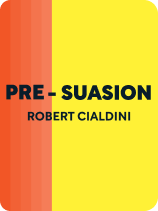

This article is an excerpt from the Shortform book guide to "Pre-Suasion" by Robert Cialdini. Shortform has the world's best summaries and analyses of books you should be reading.
Like this article? Sign up for a free trial here.
Have you ever wondered why some people are more persuasive than others? What if the key to influence lies, not in what you say, but in what happens before you speak?
In his book Pre-Suasion: A Revolutionary Way to Influence and Persuade, psychologist Robert Cialdini explores the crucial moments before persuasion occurs. Setting the stage for your message is just as important as the message itself. He shares valuable insights on how to make your audience more receptive to your ideas.
Continue reading to discover the secrets of pre-suasion and learn how to become a master of influence.
Overview of Pre-Suasion: A Revolutionary Way to Influence and Persuade
Experts in the art of persuasion, whether orators, salespeople, or politicians, often focus on fine-tuning their arguments. But, according to psychologist Robert Cialdini, this approach fails to consider another key component of persuasion—what happens before we begin conveying our argument. In his 2016 book, Pre-Suasion: Pre-Suasion A Revolutionary Way to Influence and Persuade, Cialdini argues that to make our audience receptive to our message, we must optimize the moments before persuasion.
As the author of the bestseller Influence (2006), Cialdini is one of the foremost authorities on the psychological secrets underlying successful persuasion. He’s currently the Regents’ Professor Emeritus of Psychology and Marketing at Arizona State University, and he formerly worked as a behavioral scientist for Barack Obama’s 2012 presidential campaign. In Pre-Suasion, Cialdini builds upon Influence’s foundational principles by explaining how we can effectively steer our audience’s attention before we even begin our argument.
We’ll begin by discussing Cialdini’s insight that people are particularly susceptible to influence the moment before they make a decision. Next, we’ll examine the three instruments he introduces for influencing people in that critical moment—words, images, and environments. Afterward, we’ll discuss some of the things you can use to direct your audience’s attention toward, including their preference for consistency, likable communicators, authoritative figures, and members of their in-group. Finally, we’ll consider how to anchor the behavioral changes that result from pre-suasion by getting your audience to make a commitment. We’ll also discuss pushback against Cialdini’s arguments and consider supplemental advice from other authors on how to influence people.
The Foundation of Pre-Suasion
Before delving into Cialdini’s specific strategies for effective pre-suasion, we’ll start by discussing the critical moment in the pre-suasive process—the moment immediately before your audience makes a decision. We’ll also outline the two primary reasons why such moments are critical to the decision-making process: First, because people intuitively believe these moments to be very important; and second, because people think the information they encounter just before making a decision is causally relevant to their decisions.
The Importance of the Moment Before Deciding
According to Cialdini, the key to pre-suasion lies in the insight that the most salient factors immediately before people make a decision have a disproportionate impact on that decision. He cites several scientific studies suggesting that people respond differently to requests for assistance depending on the prompt they answer immediately beforehand.
For example, he points to one study where subjects were randomly split into two groups: One was asked if they were unhappy with their social lives, while the other was asked if they were happy with their social lives. Participants who were asked whether they were unhappy were 375% more likely to respond that they were—illustrating that simply using the word “happy” makes people more aware of the positive aspects of their social relationships, while using the word “unhappy” makes them more aware of the negative aspects.
Why Are These Moments Pivotal?
Cialdini admits that these studies don’t show why the moments right before a decision have an outsize influence. To fill that gap, he argues that the objects of attention influence decisions for two reasons: People naturally believe that the objects of their attention are important and causally relevant to their decisions.
Reason #1: The Objects of Attention Are Important
First, Cialdini points to several studies illustrating that people find the current objects of their attention more important than those outside of their attention. For example, he describes how people’s perceptions of the importance of 9/11 changed with the amount of media coverage. In 2011, a research team asked people to name especially impactful historical events in the last 70 years. Two weeks before the tenth anniversary of 9/11, about 30% of respondents named 9/11 as one such event—but right around the anniversary, amid a flurry of media attention, a full 65% of respondents did. Two weeks later, that figure had dropped back to 30%. In other words, as the events of 9/11 became more present in respondents’ minds, they became more likely to deem them important.
Reason #2: The Objects of Attention Play a Causal Role
Building on his claim that individuals unconsciously assign high importance to things they’re paying attention to, Cialdini argues that people also believe that the objects of attention are causally impactful, meaning they’re relevant to the decision-making process.
To illustrate, he points to experiments in which participants observed a scripted conversation of a couple deliberating about which movie to see, with some participants seeing only the man’s face and others seeing only the woman’s. These participants consistently believed that the person whose face they saw drove the choice—if participants saw the man’s face, they believed he drove the choice to see the movie, whereas those who saw the woman’s face believed she drove that choice.
The Instruments of Pre-Suasion
Having established the foundation of pre-suasion—the fact that people are especially susceptible to influence the moment before they make a decision—we’ll now turn to the specific instruments of influence that make pre-suasion possible. According to Cialdini, there are three such instruments: language, images, and environments.
Instrument #1: Language
Cialdini says that precise word choice is an essential tool for successful pre-suasion, citing various studies that reveal how words can shape behavior and underlying opinions.
For example, in one experiment, researchers exposed one group of participants to sets of scrambled words that formed violent sentences when unscrambled (for example, “him shot she” became “she shot him”). Another group saw scrambled words that formed nonviolent sentences (for example, “him saw she” became “she saw him.”) Then, researchers had the subjects partake in an experiment that involved electrically shocking another subject and choosing the intensity of the shocks. Cialdini notes that the results were shocking: Those exposed to violent language beforehand chose shock levels 48% higher than those exposed to nonviolent language, suggesting the words influenced their behavior.
In another study, researchers examined the impact on people who read reports likening crime to a “beast” versus those who read reports likening crime to a “virus.” Cialdini writes that by changing a single word in the report, researchers found that readers came to drastically different conclusions about crime: Those who read the report comparing crime to a beast were more likely to prefer punitive solutions that involved catching and imprisoning criminals, whereas those who read the report comparing crime to a virus became more likely to prefer a systemic approach focused on remedying the underlying causes of crime.
Instrument #2: Images
Cialdini clarifies that words aren’t the only effective vehicle for pre-suasion: Carefully tailored images can also unconsciously influence people’s behavior. Images, he says, can even propel people toward success when used correctly.
To illustrate, Cialdini cites a study by researchers who sought to improve productivity at a fundraising call center. In this study, workers were given a piece of paper outlining the key facts about the university for which they were fundraising. Half of these fact sheets were printed on blank sheets of paper, while the other half were printed on paper with a photograph of a victorious runner finishing a race. On average, the employees whose fact sheets included the image of the runner raised 60% more money than their counterparts. Thus, Cialdini suggests that the image partially induced higher achievement among these workers.
Instrument #3: Environments
Cialdini contends that specific cues in the environment can affect performance, both in school and at work. In turn, Cialdini implies that to pre-suasively induce a change in our audience’s behavior, we should carefully tailor our audience’s environment.
Regarding classroom performance, Cialdini points to research examining how to increase female students’ scores on standardized math tests. Researchers have found that several small changes to the testing environment consistently increase female students’ scores: including only female students in the testing room, using female proctors, and not asking students to write their gender at the beginning of the test. According to Cialdini, these changes make female students less cognizant of the stereotype that women are worse at math, in turn boosting their performance.
Regarding work performance, Cialdini discusses the anecdotal experience of a manager at a consulting firm who realized that consultants’ performance creating employee incentive plans increased significantly when they worked in central offices with glass windows. According to Cialdini, this was because the consultants created better incentive plans when they were surrounded by (and thus constantly aware of) the employees for whom they were creating the plans.
Pre-Suade by Aligning With People’s Preferences
Cialdini identifies instruments for steering people’s attention in the moment before deciding. Here, we’ll discuss how to use these instruments. We’ll consider ways you can direct your audience’s attention by aligning with their preferences—three of which (desire for consistency, deference toward authority, and desire for likability) are originally from Cialdini’s previous book, Influence, and one of which (the importance of unity) is new to Pre-Suasion.
Preference #1: Consistency
Cialdini first explains that people are naturally inclined to think and act in a way that’s consistent with their pre-existing beliefs and actions. Accordingly, reminding people of this desire for consistency can be a powerful tool for successful pre-suasion.
To demonstrate this desire for consistency, Cialdini points to a study examining how best to increase the participation rate of those who signed up for a blood drive. The researchers found that during a reminder call the day before the blood drive, eliciting verbal confirmation from participants made it significantly more likely that they would show up the next day—the participation rate increased from 70% to 82%.
For this reason, effective pre-suasion often involves making our desire for internal consistency more salient. For example, vegetarianism advocates from People for the Ethical Treatment of Animals (PETA) might appeal to the fact that most individuals think it would be wrong to consume their household pets, even though they regularly consume other animals. In so doing, PETA would try to convince people to become vegetarians by appealing to their desire for internal consistency.
Preference #2: Authority
Cialdini admits that shifting people’s focus toward their internal desire for consistency isn’t enough if you—the pre-suader—don’t come across as authoritative. According to Cialdini, people naturally defer to those whom they perceive as authoritative, meaning that effective pre-suaders should attempt to underscore their own credibility.
To illustrate the tendency to defer to authority, Cialdini discusses an experiment in which individuals were asked to answer complex questions about economics while undergoing a brain scan. He notes that when the participants were initially evaluating these questions, their brain activity surged in the area responsible for high-level problem-solving. However, when these participants heard proposed answers from professional economists, their brain activity crashed as they mindlessly deferred to the expert.
Cialdini concludes that making our own authority salient can be a winning strategy for pre-suasion. To do so, he recommends that you establish your credibility by admitting a shortcoming early in conversation, since people perceive those who are candid about their weaknesses as more credible. For instance, if you’re a politician on the campaign trail, confessing to previous mistakes—say, support for an unsuccessful bill in years past—could actually make you seem more authoritative in the eyes of your constituents.
Preference #3: Likability
While people place great weight on the views of authoritative experts, they’re less likely to do so if the experts are unlikable. Conversely, Cialdini writes that people are inclined to agree with those whom they find likable, which suggests that drawing attention to your likable traits is an excellent pre-suasive strategy. He recommends two strategies for making yourself more likable: Highlight similarities with your audience and give your audience compliments.
Strategy #1: Highlight Similarities
Cialdini points out that people are predisposed to like those who are similar to them. He relates that there are many examples of this phenomenon: Babies, for instance, are more likely to smile at adults who mimic the babies’ facial expressions.
In the context of pre-suasion, then, Cialdini implies that we should draw attention to features that we share with our audience. For example, imagine that you’re a door-to-door salesman in Boston, where the majority of your potential customers are fans of the New England Patriots. To effectively pre-suade—and thereby increase your sales—you could choose to wear a Patriots hat that highlights your similarities with your audience.
Strategy #2: Give Compliments
In addition to underscoring similarities with your audience, Cialdini also recommends that you give genuine compliments to win people’s affection. To show as much, Cialdini points to a study in which students received fliers from a clothing store that praised them for being “fashionable and stylish.” In response to the fliers, these students reported significantly more positive attitudes toward the store and a higher likelihood of shopping there.
Paying people compliments can make you seem more likable, thus making you more effective at pre-suasion. For example, imagine that you’re a teacher seeking high performance scores from your students to bolster your case for receiving a raise. Just before distributing the questionnaires, you could remind your students that they’ve been a joy to have in class to steer them toward more favorable reviews.
Preference #4: Connectedness
Although consistency, authority, and likability are all potent desires, Cialdini clarifies that one more desire is even more powerful: connectedness (which he calls “unity”). According to Cialdini, individuals are especially susceptible to influence from people with whom they feel connected. Further, he explains that this connection takes two forms: connection through identity and connection through activity.
Form #1: Connection Through Identity
Cialdini contends that people feel deeply connected with fellow members of a shared identity group, or “in-group,” such as their family, country, or religion. He relates that this unity has an evolutionary origin: Because humans are programmed by natural selection to pass down their genetic material, they automatically favor those who share this genetic material—that is, their families. In fact, Cialdini notes that neuroscientists have even found that people tend to project their own personality traits onto other in-group members, suggesting that they consider those who share their identities as extensions of themselves.
Given the importance of shared identity, Cialdini suggests that we should direct our audience’s attention toward any mutual aspects of identity to pre-suade them. For example, an Italian politician giving a speech on the eve of election day could begin the speech with, “As your fellow Italian,” to underscore the identity that they share with voters. Alternatively, a corporate executive could use language likening the company to a family to foster a sense of unity among employees.
Form #2: Connection Through Activity
What if you want to pre-suade someone but you don’t share an identity with them? Cialdini suggests that we can manufacture a sense of unity through collective action, citing an array of studies to show as much.
For instance, in one study, researchers separated participants into two teams—one that walked in lockstep and one that walked out of sync—before having the teams play a game in which they chose between maximizing self-interest versus maximizing collective success. These researchers found that participants whose teams walked in lockstep were significantly more selfless (and thus more connected) during the subsequent game, whereas participants whose teams walked out of sync played more selfishly.
Of course, Cialdini doesn’t recommend asking people to march in lockstep with you to win them over. But he does note that, in the workplace, you can implement unifying activities by designing projects that require collaboration between team members. He explains that because employees feel a sense of ownership over projects they partake in, allowing employees to jointly participate in projects can instill a sense of mutual ownership and connection. Thus, creating collaborative projects could make employees more influenceable, as we’re more susceptible to influence from those with whom we feel connected.
The Enduring Impact of Pre-Suasion
Cialdini acknowledges that, although the pre-suasive techniques he’s outlined might lead to short-term behavioral changes, they’re often insufficient to effect long-term change. Consequently, we’ll explain how to entrench the changes brought about through pre-suasion by eliciting concrete commitments from your audience.
The Importance of Eliciting Commitment
Cialdini explains that to generate long-term shifts in behavior, you should elicit a concrete commitment from your audience. To illustrate the impact of such commitments, Cialdini points to several studies showing that small commitments can cement behavioral changes.
For instance, in one study of medical clinics, experts sought to determine how to increase the percentage of patients who show up for scheduled follow-up appointments. They found that the most successful approach involved asking patients to write down the details of these follow-up appointments themselves, rather than having the receptionist do so. Cialdini explains that in so doing, the patients were making a small commitment that made them 18% more likely to attend their follow-up appointments.
Cialdini relates that in addition to shifting behaviors, commitments can also shift long-term beliefs. For example, in one experiment, researchers exposed participants to a happy story. They then asked one group of participants to rate a painting and another group to observe the painting. Five days later, only those who’d rated the painting reported preferring it to other paintings, suggesting that the commitment of rating the painting positively made their positive opinion of it more entrenched.
Cialdini suggests that following a successful instance of pre-suasion, you should elicit some form of commitment to maximize the chance of effecting lasting change. For example, local politicians at a rally might elicit verbal commitments from their constituents that they’ll vote for them in the next election, unlike the majority of voters who never vote in local elections. Likewise, bosses could ask their employees via email for a commitment to finish a project by a certain deadline. In either case, securing a commitment is the crucial step after you’ve finished the pre-suasive process.

———End of Preview———
Like what you just read? Read the rest of the world's best book summary and analysis of Robert Cialdini's "Pre-Suasion" at Shortform.
Here's what you'll find in our full Pre-Suasion summary:
- The moment when people are particularly susceptible to influence
- The first step you should take when you want to persuade someone
- Why a brilliant argument isn’t enough to convince some people







Elizabeth– I have just finished reading your review of my book Pre-Suasion and found it the best summary of the ideas and implications of the book’s content that I have seen. Congratulations on your ability to comprehend and present the material so well.